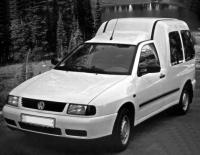Volkswagen Polo Classic/Polo Variant
The third generation Polo was produced in Spain with the Classic sedan and the Polo Variant station wagon in versions for Europe in parallel with the twin Seat Cordoba until 2002, and the Argentine branch of VW continues to release in the future. The model is equipped with petrol engines 1.4, 1.6 and 1.8 liters, as well as diesel engines 1.9 SD or 1.9 TDI with direct injection.
Volkswagen Caddy
The 700-kilogram Caddy delivery van, built on a reinforced third-generation Polo platform and unified with a similar SEAT Inca model, is now living its life in the Spanish and Argentine branches of VW. The capacity of the van due to the increased height of the rear of the body reaches 2.9 m3. The cargo-passenger version of Kombi, equipped with rear seats for three passengers, can carry up to 500 kg of cargo. Swivel pillars of the rear door swing open by 180°, which greatly facilitates loading and unloading. Power steering, central locking and an anti-theft alarm are standard. For an additional fee, ABS, power windows and tinted windows are installed. The choice of engines is quite wide: from gasoline injection to turbodiesels with direct injection and intercooler, providing excellent fuel efficiency while maintaining the dynamics of a passenger car.
The first Caddy pickup appeared in the Yugoslav city of Sarajevo in 1982. When it was created, a standard technique for that time was used: they took a serial passenger car, lengthened the base, attached a cargo compartment instead of the rear part of the body and strengthened the rear suspension. Initially, the Volkswagen Caddy was created exclusively as a delivery van: its interior was absolutely not suitable for transporting passengers. The car was made on the platform of the first generation Golf model, and borrowed a lot from Polo in appearance. For example, the front part of the body up to the doors and the rear-view mirror.
The model is equipped with a 1.6-liter gasoline carburetor engine with 81 hp. The rear suspension is spring, the chassis is reinforced. As an option, a plastic top was installed on the pickup truck with or without a lifting rear sash. The release of the first generation continued until 1992.
Then, in 1995, came the second Caddy. The principle of construction has been completely preserved: the front end is from a compact and cheap B-segment car, an extended wheelbase and a spacious body. The diesel engine, of the options, only the most necessary, because the car had to be affordable. It was in great demand not only in Western Europe, but also in our country. Small businesses, food distributors and other organizations that constantly move small quantities of goods or equipment have been very pleased with the Caddy.
Production of the second generation Caddy ceased last year. Now the equipment on which it was made is being dismantled and is being prepared for shipment to Argentina, where its production will soon resume. Its price, of course, will be lower than that of the Caddy-3.
In 2000, the light van market was undergoing a revolution. The global giants of the auto industry presented new models that were designed not only for the transport of goods, but also for passenger operation. Renault releases Kangoo, then came Opel Combo and Ford Tourneo. Following the trends of the modern market and demand, Volkswagen releases a new Caddy on the Golf V chassis.
The New Caddy family is a new generation of technological vehicles for universal use. The reliability that has become the hallmark of the previous generation of Caddy has found its continuation in the new model.


Visitor comments